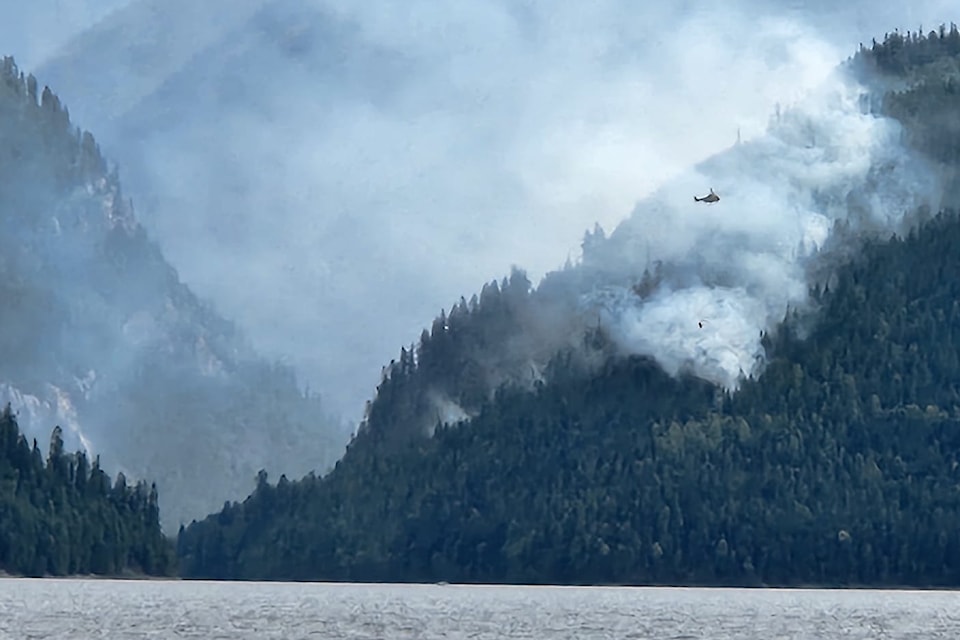UPDATE Aug. 1:
The wildfire burning east of Cherryville's Sugar Lake has now been classified as a wildfire of note.
BC Wildfire Service (BCWS) updated the status of the blaze late Thursday.
"This wildfire is highly visible or poses a potential threat to public safety," the stage reads.
Latest mapping now estiates the blaze is 1,261 hectares, down from the previously projected 1,993.
"Today, Aug. 1, heavy equipment is continuing to support 34 personnel with machine guard along the west flank," the service's response update reads. "Helicopters will be available throughout the day to support ground personnel."
Evacuation orders and alerts remain unchanged.
UPDATE July 31:
Air support has been pulled from the Sitkum Creek wildfire burning near Sugar Lake.
But ground crews remain on scene battling the blaze, which remains approximately 1,993 hectares.
"There was no growth to this fire overnight," BC Wildfire Service reports. "Today, July 31, heavy equipment is continuing to support 34 personnel with machine guard along the west flank."
ORIGINAL July 29:
Minimal growth at the Sitkum Creek wildfire has led to some evacuations being lifted.
The evacuation order issued for the east side of Sugar Lake has been downgraded for properties 1616, 1622, and 1630 Sugar Lake Road.
The order for the rest of the lands on the east side remains in place and includes: all lands east of Sugar Lake, from the southern end to the northern tip, and from the east shore to a line north-south through Initiative Peak.
The evacuation alert has also been rescinded for properties along the west shore of Sugar Lake.
Additionally, the Okanagan Shuswap Forest District has modified the current road closure to begin at the 2.5 km mark of Kate Creek Fire Service Road to limit access to the remaining evacuation area.
Residents should remain prepared to vacate their homes on short notice should fire conditions change. An Evacuation Order may need to be re-issued and, if deemed necessary, the Evacuation Order process will re-commence.
To ensure a safe homecoming to properties remaining on evacuation alert, residents should consider the following while preparing to return to their homes:
• Walk around the perimeter checking for electrical wires, the smell of gas or hanging debris.
• Enter your home with caution and check that the main power breaker is off.
• Do not use your sewage disposal system unless you know it is capable of handling waste.
• Refrigerated food - discard refrigerated food that has spoiled, as well as food that has been stored in a refrigerator that has lost power. When in doubt, throw it out.
• Frozen food - discard frozen food that has thawed. If your freezer has been exposed to fire, or has been without power for more than three days, toss the contents entirely.
• Canned food – canned goods should be safe, unless the can has bulged, rusted or is badly dented. Wash and disinfect all cans exposed to smoke. Food stored in glass jars and exposed to heat should be thrown out.
• Don’t hesitate to ask for help for mental or psychological recovery. The BC Mental Health Support Line is open 24 hours a day at 310-6789 (no area code).
• If loss of property has been identified, call your insurance representative to start your claim.
Fire information officer Cassidy Martin said Saturday morning, July 27, that the blaze is still an estimated 1,993 hectares in size.
"The weather has helped us for sure," Martin said. "The cooler temperatures have helped cool the fire behaviour, and there have been little bits of precipitation here and there, which always helps."
BC Wildfire has 23 personnel at the fire, with the support of helicopters bucketing water as needed. Heavy equipment is also being utilized.
The wildfire is burning at rank one and rank two, meaning the fire is smouldering with minimal pockets of open flame, and an overall slow rate of growth, Martin said.
The wildfire, which was discovered on July 18, is still classified as being out of control, meaning it is still anticipated to spread beyond its current perimeter.



